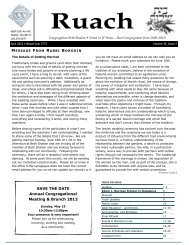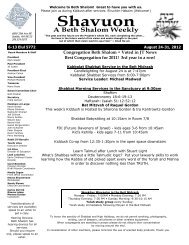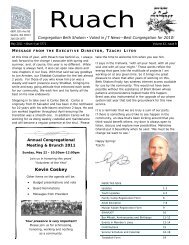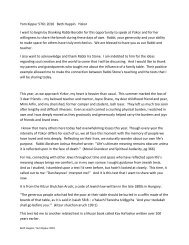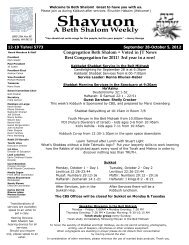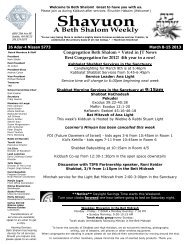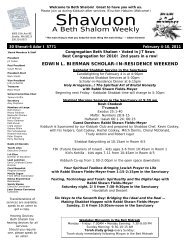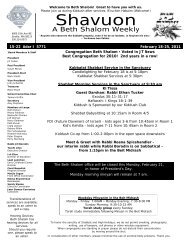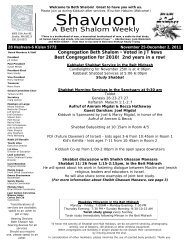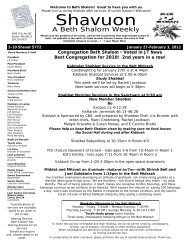Gabbai Manual - Congregation Beth Shalom
Gabbai Manual - Congregation Beth Shalom
Gabbai Manual - Congregation Beth Shalom
- No tags were found...
You also want an ePaper? Increase the reach of your titles
YUMPU automatically turns print PDFs into web optimized ePapers that Google loves.
them. Please place them on one of the desks in the office, open to the damaged or written on page sothe staff can take care of the problem.GreetingAn important part of the gabbi’im job is to help make congregants and guests feel welcomed andcomfortable in our synagogue. Everyone should be greeted with a smile and a friendly “hello” or“Shabbat <strong>Shalom</strong>”. This is especially true for visitors or first timers. If you see someone you don’trecognize, introduce yourself, welcome them to the shul, etc. If you’re not sure if they have been at<strong>Beth</strong> <strong>Shalom</strong> before, ask “Is this your first time here?”, or “I don’t remember meeting you before”. It isalso helpful to know if the guest is a Kohen or a Levi.Recently one of our members spent the year in Israel and wrote of her synagogueexperiences there:“My observations as a newcomer at synagogues here is that shuls that have someonewho greet me at the door, say “Shabbat <strong>Shalom</strong>”, and hand me a siddur, really feelso significantly more welcoming. Basically, you shouldn’t underestimate theimportance of what you are doing. A smile, a hello; it really makes a hugedifference. I now see that even a brief greeting makes a huge difference. We’ve beenplaces where nobody has even said hello to us and if feels awful. Just a “hello”changes everything. Seems so simple. And an announcement from the bimah ofwelcome to newcomers is only meaningful if there is a personal hello by members ofthe congregation when you come in the door and when services end. It doesn’t feellike the bimah welcome is sincere without the personal touch that can only come fromthe members.”Kippot and TallisimKippot and tallism should be worn by all men in the sanctuary. Women going on the bimah shouldwear kippot, and should wear tallism for Torah reading, aliyot, gelilah, and hagbah. Women are NOTrequired to wear tallism for opening and closing the ark or for the four special readings (peace, country,government, Israel).2004, page 3



